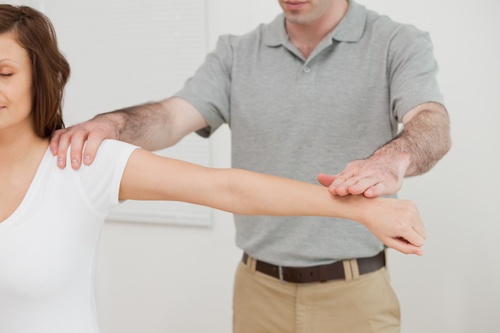It seems that the philosophy of less care (diagnostic tests, injections, medications & surgery) is better care. This current study intrigued me because it looked at the results of nonoperative care for rotator cuff tears.

Although I am not a fan of the SPADI, the positive in the study is that pain and functional ability were considered for each patient. Because the study used the SPADI and used serial testing (reassessment at 3, 6,12 and 18 months), you’ll need to view the full text to see if a minimal clinically important difference occurred. Based on this study, when the SPADI is completed more frequently than initial evaluation and at discharge, the minimal clinically important difference is 18 points.
Since we know that beliefs impact outcomes, it would have been nice to know how much improvement the patient believed would occur. We already know that the patient had diagnostic testing and was informed that a rotator cuff tear was present in the shoulder.
FOTO risk adjusts for factors outside of a clinician’s control. A few factors not taken into consideration by FOTO include marital status, alcohol use and the intensity in which a patient uses his or her shoulder during the day. FOTO has been capturing data on educational level to perform an analysis on the impact of education on outcomes.
We know from work done on patients who have had a cervical whiplash that fatty infiltration into cervical musculature affects their outcomes. This study highlights the same finding. Fatty infiltration into the rotator cuff musculature affected functional outcomes negatively.
You’ll find the abstract to the recent study below.
Predictors of Pain and Functional Outcomes After the Nonoperative Treatment of Rotator Cuff Tears.
Abstract
BACKGROUND:
Optimal patient selection is key to the success of nonoperative treatment for rotator cuff tears.
PURPOSE:
To assess the predictors of pain and functional outcomes in a longitudinal cohort of patients undergoing nonoperative treatment.
STUDY DESIGN:
Cohort study; Level of evidence, 2.
METHODS:
A multicenter cohort of patients with rotator cuff tears undergoing nonoperative treatment was recruited from March 2011 to February 2015. Patients completed a detailed health questionnaire, completed standardized shoulder questionnaires including the Shoulder Pain and Disability Index (SPADI), and underwent magnetic resonance imaging. In addition to baseline assessments, patients received follow-up questionnaires at 3, 6, 12, and 18 months. Longitudinal mixed models were used to test predictors of the SPADI score, and interactions with time were assessed.
RESULTS:
In our cohort of 70 patients, being married as compared with being single/divorced/widowed (P = .02), a shorter duration of symptoms (P = .02), daily shoulder use at work that included light or no manual labor versus moderate or heavy manual labor (P = .04), alcohol use of 1 to 2 times per week or more as compared with 2 to 3 times per month or less (P = .007), and absence of fatty infiltration (P = .0009) were significantly associated with decreased SPADI scores (improved shoulder pain and disability) over time. When interactions with time were assessed, having a college level of education or higher compared with less than a college education showed a differential effect over time, with those with a college level of education or more having lower SPADI scores (P = .004). Partial-thickness tear versus full-thickness tear also had an interaction with follow-up duration, such that those with a partial-thickness tear had lower SPADI scores (P = .0002).
CONCLUSION:
Longitudinal predictors of better outcomes of the nonoperative treatment of rotator cuff tears included being married, having at least a college education, shorter duration of symptoms, light or manual labor in daily work, alcohol use of 1 to 2 times per week or more, partial-thickness tear, and absence of fatty infiltration of the rotator cuff. Our results suggest that nonoperative treatment should be performed early for optimal outcomes. These data can be used to select optimal candidates for the nonoperative treatment of rotator cuff tears and to assist with patient education and expectations before treatment.
Orthop J Sports Med. 2018 Aug 3;6(8):2325967118788531. doi: 10.1177/2325967118788531. eCollection 2018 Aug.
{{cta(‘c6ecd159-44e1-4eb3-9940-fbb5cb2761d5’)}}

Leave a Reply